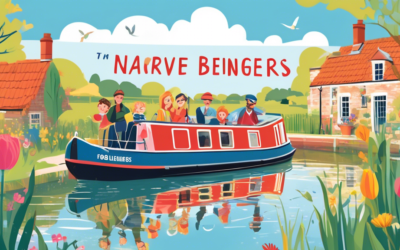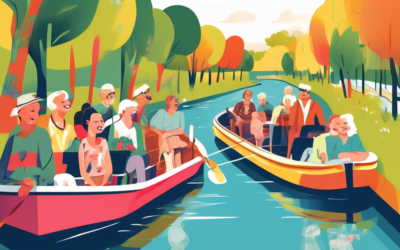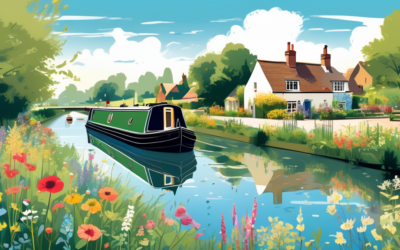Barging Through Time: The History of England’s Canals
The serene landscape of England, with its picturesque countryside and vibrant history, is interwoven with a network of canals that once powered the industrial heart of the nation. These waterways, which now serve as peaceful retreats for canal boat enthusiasts and nature lovers alike, hold stories of innovation, industrial revolution, and the changing face of transportation. As we embark on this journey through time, we’ll explore the evolution of England’s canals, with a special focus on the charming regions of the Four Counties, the Cheshire Ring, and the Llangollen Canal.
The Dawn of Canal Age
The story of England’s canals begins in the 18th century, a time when the country was on the cusp of the Industrial Revolution. Before the advent of canals, goods were predominantly transported by packhorse or on rough, often impassable roads. The need for a more efficient transportation system was evident, and canals became the innovative solution. The Bridgewater Canal, opened in 1761 to transport coal from mines at Worsley to Manchester, marks the birth of the modern canal system. This pioneering endeavour not only reduced the price of coal in Manchester but also demonstrated the potential of waterways as highways of commerce.
The Golden Age of Canals
Following the success of the Bridgewater Canal, a canal-building frenzy ensued, heralding what is often referred to as the Golden Age of Canals. Between 1760 and 1830, over 4,000 miles of navigable waterways were constructed across England. These canals played a crucial role in the industrial expansion, allowing the efficient transportation of heavy and bulk goods across the country. Notable constructions from this period include the Grand Union Canal, the Leeds and Liverpool Canal, and the Trent and Mersey Canal, which form part of the Four Counties Ring. This circuit, beloved by modern canal enthusiasts, offers an immersive journey through English industrial heritage and natural beauty.
Engineering Marvels and Social Impact
The construction of canals was a significant engineering undertaking, involving the creation of locks, aqueducts, and tunnels to navigate the varied English landscape. Among these, the Pontcysyllte Aqueduct on the Llangollen Canal stands out as an iconic marvel. Completed in 1805 by Thomas Telford and William Jessop, it is the longest and highest aqueduct in Britain, offering breathtaking views of the Dee Valley below. This UNESCO World Heritage Site epitomizes the ingenuity and ambition of canal engineers of the time.
Canals also had a profound social impact, transforming rural landscapes and fostering the growth of new towns and industries. They were the veins through which the lifeblood of the Industrial Revolution flowed, facilitating not only the transport of goods but also the migration of workers and the exchange of ideas. Along the Cheshire Ring, the Macclesfield Canal contributed to the prosperity of the silk mills in Macclesfield, while the Rochdale Canal aided the cotton trade in Rochdale and Manchester.
Decline and Renaissance
The advent of railways in the mid-19th century marked the beginning of the decline for canals as the primary mode of industrial transport. Railways offered faster and more reliable transportation, leading to the gradual disuse and neglect of many canal routes. However, the story of England’s canals does not end here. The latter half of the 20th century witnessed a renaissance of interest in the preservation and restoration of these historic waterways. Thanks to the efforts of enthusiastic volunteers and charitable organizations like The Canal & River Trust, many canals have been revitalized as leisure destinations.
The Living Canals of Today
Today, the canals of England are vibrant waterways bustling with life. They serve as idyllic corridors for narrowboats, walkers, and cyclists, offering a unique perspective on the country’s industrial heritage and natural beauty. The Four Counties, the Cheshire Ring, and the Llangollen Canal are particularly popular among canal boat hirers. These routes, with their blend of historic towns, rural tranquility, and engineering wonders, provide an unparalleled opportunity to slow down and appreciate the simpler pleasures of life.
Tips for Canal Boat Enthusiasts
If you’re considering exploring England’s canals on a canal boat, here are a few tips to make your journey memorable:
- Plan your route: Whether you’re interested in the rich history of the Cheshire Ring, the architectural feats along the Llangollen Canal, or the scenic beauty of the Four Counties, planning your route in advance will help you make the most of your trip.
- Respect the waterways: Remember that the canals are shared with wildlife and fellow enthusiasts. Acts of kindness and respect go a long way in ensuring everyone enjoys their experience.
- Embrace the pace: Canal boating is about embracing the slower pace of life. Take the time to enjoy the journey, the landscapes, and the history that envelops you.
England’s canals are a testament to the country’s innovative spirit and industrial legacy. As we boat through these historic waterways, we’re not just traversing a geographical landscape but barging through time itself. The canals invite us to reflect on the past while appreciating the beauty and tranquility of the present. So, whether you’re a seasoned barger or a curious visitor, the canals of the Four Counties, the Cheshire Ring, and the Llangollen Canal await to offer you an unforgettable journey through England’s heartland.
Find dates and rates for your next canal boat holiday with Floating Holidays






0 Comments